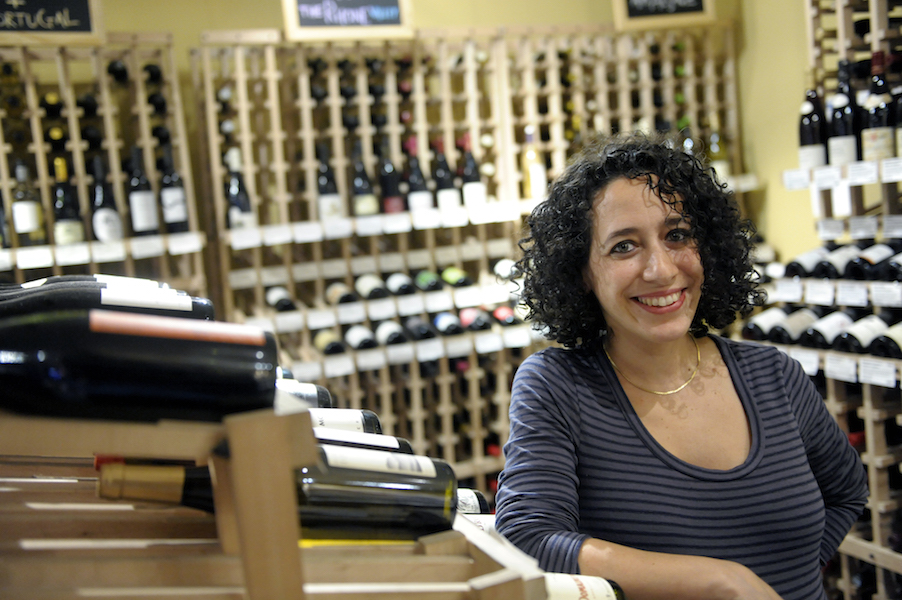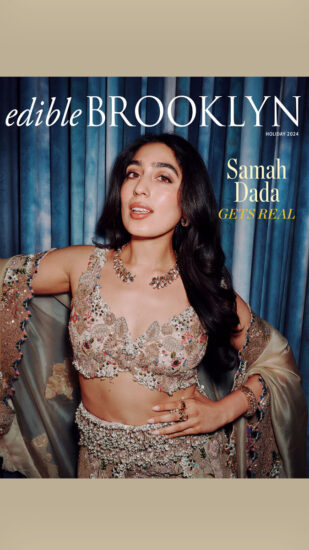Drinkers have a rainbow of eco labels to consider. The O-word is straightforward enough, made from grapes untouched by synthetic fertilizers or pesticides. “Biodynamic” vintners prune and pick with the phases of the moon. “Sustainable” is virtuous but vague and “local” means made in your time zone, maybe even your Zip code. But then there’s that catch-all category “natural,” another shade of gray in a cloud of questions: Is this bottle better for the planet? For my body? Or is all this holistic hullaballoo a heap of hooey?
Not if it comes from Jenny Lefcourt, it’s not. She is the Jenny of Jenny & Francois Selections, an importer and distributor of wines in that last category, natural—for which she has a deep and detailed definition, but in a nutshell means wines made with the least possible use of chemicals, additives and overly technological procedures. And while she didn’t start out in search of that specialty, spreading the all-natural gospel has become her life’s mission. The business she co-owns with her ex-husband, François Ecot, started small in 2000 with only a backpack of bottles brought back on a plane (remember when you could do such things?) and from the get-go, the duo has dealt only with producers who eschew chemical intervention and technological manipulations that can strip a wine of its sense of place, personality quirks and out-and-out individuality. Instead they distribute wines that taste like a moment, a time, a place, a season.
The response has been phenomenal. Today Jenny & Francois distribute the wines of nearly 50 French, Italian, Spanish and American natural producers to 15 states. And they are beloved in Brooklyn, selling to shops like Gnarly Vines, Natural Wine Company, Dandelion Wine and Fermented Grapes, and many restaurants including The Farm on Adderley, Home/Made, Thirst Baravin, Bacchus Bistro, No. 7, Franny’s and many more. “They’ve been bringing natural wines to the States for years, long before most people had heard of it,” says Michael Andrews, owner of Natural Wine Company in Williamsburg. And he adds, “the wines they import taste good—the harder part, in our opinion.”
But none of this was part of Lefcourt’s life plan—don’t think she grew up with a silver tastevin around her neck, sipping vintage Bordeaux in the family cellar, forming a vague mission to tell the world a thing or two about what we should be drinking. Quite the opposite. Lefcourt is a native New Yorker whose parents did little wine drinking when she was growing up. “If anything, when we’d go out, my mom would say, ‘I’ll have the house white,’ and it was the ’70s so what was that house white? Probably nothing very good, or at least not at the places we went. So I didn’t have any wine background or connection to wine culture in any way.”
Literature studies at Cornell and Harvard put her on the path to professordom, but an opportunity to study with feminist philosopher Hélène Cixous lured her to Paris, where she saw the world through different colored glasses, namely the cab franc-holding kind. She finished her PhD, but along the way realized she wanted out of the ivory tower.
She’d met Francois, a musician who tuned accordions for a living and, like Lefcourt, was having a “What Do I Want To Do With My Life?” kind of crisis. Her year in Paris turned into many, and they spent days off in the countryside tasting wine. At first it was just for fun, but as their passion grew, they started visiting more vineyards and asking more questions. Eventually Francois decided to take the leap and go to winemaking school, but that didn’t answer all the life questions for either of them. “He apprenticed at a bunch of places and didn’t know what he was going to do with that. And all I knew was I wanted to divide my life between New York and France.”
An impulsive phone call changed everything. The pair had been wowed by bottles from Hervé Souhaut of Domaine Romaneaux-Destezet in the northern Rhone, which they discovered at a tasting near Paris. “The wines were absolutely gorgeous,” recalls Lefcourt. “They have this incredibly floral, ephemeral quality—just magic, magic wines. And one day we were driving south and I said, ‘Oh here we are, St. Joseph! We should go see that guy!”
So they did what any wine loving couple, half-drunk on love, would do: They pulled over, cold-called a man they’d never met and asked if they could drop in. He agreed and the wove their little car over and around a series of slopes to the beautiful farmhouse where the winemaker lived and worked. “We started tasting his wines, and then he opened friends’ wines, and he just opened wine after wine and we ended up having this huge discussion. We must have been standing in the cellar for eight hours! Long into the night his wife finally came out and said ‘Why don’t we give them some dinner? I don’t think they’re going to drive back down the mountain tonight!’” Over that meal, peppered with conversation about the treachery of modern methods and the beautiful bottles that result from ancient arts, an idea began to take shape—that these wines deserved their own dedicated sales force. “That night was a big influence,” Lefcourt remembers with a smile, “and I’m happy to say we are repping him now. It’s one of my favorite wines still.”
While others sought out such bottles after reading about the drawbacks of conventional viticulture, the ex-academic arrived at the same destination from the opposite direction: her senses. “We’d taste these wines and be completely excited by them without knowing why,” she remembers. “But the more we asked about how they were made, we realized that the wines that really moved us all had a similar philosophy—they were people who were working organically with the vines and using minimal technological intervention in the cellar, using indigenous yeast, minimal sulfites, or no sulfites sometimes. So we didn’t start out saying, ‘Oh, let’s create an organic, biodynamic, natural wine importing company! That’s gonna be in! That’s the rising part of the market.’ We had no idea! We were touched by certain wines, and we explored how they were made, and it turned out that they were made a certain way. That was a revelation. Once we figured that out,” she says simply, “it was something we wanted to share.”
But back home, she couldn’t—many of the wines she found so compelling were unavailable and unknown in New York, and so the idea planted in that mountainside farmhouse started to sprout. On a trip home in 2000, she brought that backpack of bottles and landed a meeting with Josh Wessen, who founded the follow-your-senses wine chain Best Cellars. After just a few sips, he was sold, and Jenny & Francois were in business.
Soon after, they met with Peter Morrell at the famed Midtown wine store that shares his surname. “We had 20 wines with us,” recalls Lefcourt, “and he said, ‘I’ll taste two—choose which two.’ So we poured two and he was bowled over, and he said, ‘OK, a few more!’ And we ended up pouring all 20 for him. And they bought a pallet of Gamay.”
Things wouldn’t always be as easy. They had very little financing, and no investors, so for the first several years Lefcourt would bring samples on the plane and borrow her dad’s car to take them around town, and her office was wherever she set her laptop. But more and more retailers fell for the well-curated and ever-growing list of producers, establishing the brand as the tiny-but-mighty direct import company whose selection that was both killer and conscientious.
Their business has gotten New Yorkers drinking better in more ways than one. Talking with Lefcourt, you begin to realize that the unlisted ingredients in many conventional wines make them the perfect pairing for a dinner of feedlot beef and genetically engineered potatoes. “There are 200 additives that you can use in winemaking, and the only one that [winemakers are] required to list is sulfites,” explains Lefcourt, her sea-green eyes growing wide with astonishment and a sad sort of indignation. Things like acetaldehyde, which is listed as a baddie on the Centers for Disease Control’s Guide to Chemical Hazards (it’s used to stabilize a wine’s color); or silica gel—the stuff you find in little packets in new leather bags; it’s also added as a clarifying agent. And of course sulfur dioxide, or sulfites, which is widely used as a preservative and which, according to California’s famed wine-lab of a school, UC Davis, can be life-threatening in large quantities. “Even with sulfites, they’re not required to list how much,” explains Lefcourt. “You can have 150 to 200 milligrams of sulfites per liter—which is way more than the daily recommended intake—or you can have, say, 10 or 20 milligrams per liter. That’s a tenfold difference, and that difference isn’t printed anywhere.”
So she carefully constructed criteria of what the company will and won’t rep, insisting on things like handpicked grapes and indigenous yeast and forswearing everything from powdered tannins to lab-cultivated yeast. And then there’s the drinkability. “You just start to realize a difference of taste,” Lefcourt says. “When you taste a wine that’s acidified and has a harshness to it, or you taste a wine that’s been chaptalized, [which means it] has a lot of sugar added to it [to boost alcohol levels], there’s an imbalance. It tastes disjointed. If I drink those, I don’t feel good a few hours later.”
If Mother Earth could talk, she might say the same thing. With her in mind, Jenny & Francois have also paid attention to packaging, and recently unveiled a box-wine project called From the Tank. (“I was very nervous about it,” she says, “but we sold out in 2 seconds. People were ready for a high-quality wine in a box.”)
But despite all her expertise on what’s wrong with the wine industry, don’t expect this PhD to lecture you. She’s laid-back and gracious, with a laugh that bubbles out like a shaken-up bottle of Champagne—the exact opposite of a snooty wine insider or so-called expert of the intimidating sort. Her honesty, straightforwardness and aim-is-true palate can talk you through all those labels, easily, thoughtfully and, yes, naturally.



